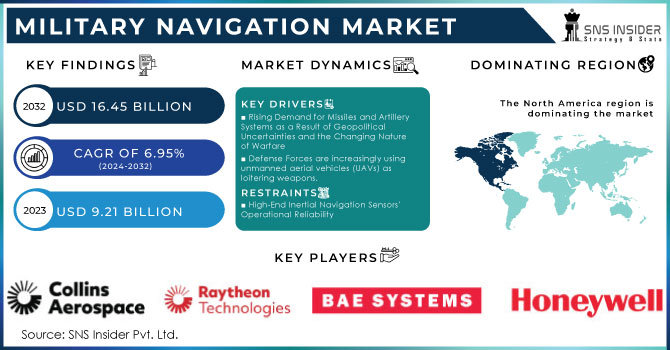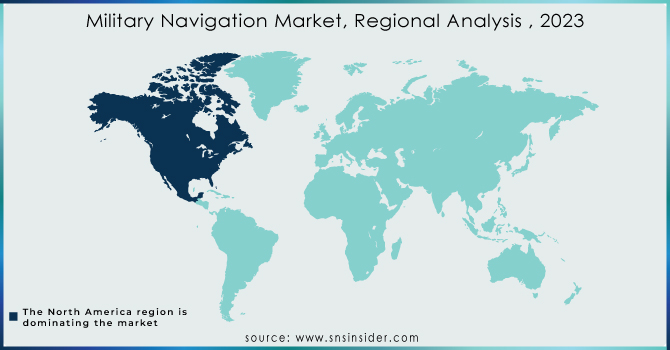Military Navigation Market Report Scope & Overview:

To get more information on Military Navigation Market - Request Free Sample Report
The Military Navigation Market Size was valued at USD 9.21 Billion in 2023 and is expected to reach USD 16.45 Billion by 2032 and grow at a CAGR of 6.95% over the forecast period 2024-2032.
A military navigation system is used on military equipment for the purpose of roaming in enemy areas. The navigation system is designed to meet the requirements for military transport aircraft. It helps to carry out strategic or strategic military transport operations in hostile environments.
The navigation system provides an efficient, flexible, and highly reliable navigation solution and guidance for various aerial systems, portable receivers, precision-guided weapons, and embedded applications. The military navigation system can be used in a variety of military deployments of power deployments, vehicle navigation, and entry support. The military navigation system offers many benefits such as military hand-held receivers, automotive aids, and GPS-enabled navigation systems for unmanned aircraft, as well as GPS-assisted aircraft navigation systems, among others. The reliability of such benefits drives the market growth of military navigation systems.
MARKET DYNAMICS
KEY DRIVERS
-
Rising Demand for Missiles and Artillery Systems as a Result of Geopolitical Uncertainties and the Changing Nature of Warfare
-
Defense Forces are increasingly using unmanned aerial vehicles (UAVs) as loitering weapons.
RESTRAINTS
-
High-End Inertial Navigation Sensors' Operational Reliability
-
Defense budget cuts in developed countries
CHALLENGES
-
Inertial Navigation System Measurement Errors
-
High Development Costs for Military Navigation Equipment
OPPORTUNITIES
-
New Generation Air and Missile Defense Systems are in high demand.
-
Anti-jamming capabilities are being integrated into navigation systems.
Aviation The market is predicted to increase at the fastest CAGR over the forecast period, owing to factors such as increasing military aircraft orders for combat aircraft, military helicopters, and military transport aircraft.
Marine Due to factors such as the rising installation of military navigation systems on shipboard for seamless flow of navigation information or data, the market is likely to develop at a substantial CAGR over the forecast period.
Ground Due to factors such as increased demand and the employment of armoured vehicles to carry out combat operations, the segment is likely to rise at a positive CAGR during the forecast period.
Space Due to factors such as increasing demand and the usage of satellites for mapping, positioning, and navigation, the category is likely to increase at a significant CAGR over the forecast period. The Command & Control Component is expected to reflect significant growth in the market during the period due to the growing need for central management and administrative areas to provide early warning for enemy ships or aircraft.
Intelligence, Surveillance & Reconnaissance (ISR) The segment is expected to dominate the market and is expected to grow at a very high CAGR during the review period, due to factors such as the growing need for awareness of conditions in military operations and rising geospatial use. wisdom.
The Combat & Security Sector is expected to grow with a steady CAGR during the forecast period, due to the growing need for improved intelligence collection, planning, decision-making, and command and control functionality expected to further component growth. Identification and Direction The segment is expected to reflect an effective growth rate during the forecast period due to the increasing adoption of targeting programs and guidelines.
Search & Rescue (SAR) The segment is expected to grow with a positive CAGR at the time of forecasting, due to factors such as the adoption of various sonar technologies for offshore operations. Part of the computer system was flooded during the update due to the growing demand for advanced navigation systems that support a variety of devices such as radar, sonar, inertial navigation system, and GPS receiver. These sections enable soldiers to obtain accurate local information.
Service The segment is expected to grow at a higher CAGR at the time of forecasting, due to factors such as the need for repair training, teacher-led training, computer-based training, on-the-field support and maintenance and equipment repair services.
KEY MARKET SEGMENTATION
By Grade
-
Navigation Grade
-
Tactical Grade
-
Space Grade
-
Marine Grade
By Application
-
ISR
-
C2
-
Combat & Security
-
Targeting & Guidance
-
SAR
By Platform
-
Ammunition
-
Aviation
-
Ground
-
Marine
-
Unmanned Vehicle
-
Space
By Component
-
Hardware
-
Software
-
Service
REGIONAL ANALYSIS
In terms of revenue, the North American market dominates the global industry and is predicted to rise rapidly over the forecast period. The presence of important players in this region is a significant element driving the growth of the target market in North America. Europe's market is predicted to rise rapidly, followed by Asia Pacific, the Middle East and Africa, and Latin America. In the near future, the Europe market is expected to account for the second-highest revenue share. Another factor expected to drive worldwide market expansion over the forecast period is the increasing adoption of advanced technology in the Asia Pacific region.

Need any customization research on Military Navigation Market - Enquiry Now
REGIONAL COVERAGE:
-
North America
-
USA
-
Canada
-
Mexico
-
-
Europe
-
Germany
-
UK
-
France
-
Italy
-
Spain
-
The Netherlands
-
Rest of Europe
-
-
Asia-Pacific
-
Japan
-
south Korea
-
China
-
India
-
Australia
-
Rest of Asia-Pacific
-
-
The Middle East & Africa
-
Israel
-
UAE
-
South Africa
-
Rest of Middle East & Africa
-
-
Latin America
-
Brazil
-
Argentina
-
Rest of Latin America
-
KEY PLAYERS
The Key Players are Collins Aerospace, Honeywell International Inc., Intelsat Corporation, Cobham Defence Communications, Thales Group, Raytheon Technologies, BAE Systems, Summitek Instruments, Inc., Northrop Grumman, Safran S.A. & Other Players.
| Report Attributes | Details |
|---|---|
| Market Size in 2023 | US$ 9.21 Billion |
| Market Size by 2032 | US$ 16.45 Billion |
| CAGR | CAGR of 6.95% From 2024 to 2032 |
| Base Year | 2023 |
| Forecast Period | 2024-2032 |
| Historical Data | 2020-2022 |
| Report Scope & Coverage | Market Size, Segments Analysis, Competitive Landscape, Regional Analysis, DROC & SWOT Analysis, Forecast Outlook |
| Key Segments | • By Grade (Navigation Grade, Tactical Grade, Space Grade and Marine Grade) • By Application (ISR, C2, Combat & Security, Targeting & Guidance, SAR) • By Platform (Ammunition, Aviation, Ground, Marine, Unmanned Vehicle, Space) • By Component (Hardware, Software, Service) |
| Regional Analysis/Coverage | North America (USA, Canada, Mexico), Europe (Germany, UK, France, Italy, Spain, Netherlands, Rest of Europe), Asia-Pacific (Japan, South Korea, China, India, Australia, Rest of Asia-Pacific), The Middle East & Africa (Israel, UAE, South Africa, Rest of Middle East & Africa), Latin America (Brazil, Argentina, Rest of Latin America) |
| Company Profiles | Collins Aerospace, Honeywell International Inc., Intelsat Corporation, Cobham Defence Communications, Thales Group, Raytheon Technologies, BAE Systems, Summitek Instruments, Inc., Northrop Grumman, Safran S.A. |
| DRIVERS | • Rising Demand for Missiles and Artillery Systems as a Result of Geopolitical Uncertainties and the Changing Nature of Warfare • Defense Forces are increasingly using unmanned aerial vehicles (UAVs) as loitering weapons. |
| RESTRAINTS | • High-End Inertial Navigation Sensors' Operational Reliability • Defense budget cuts in developed countries |

